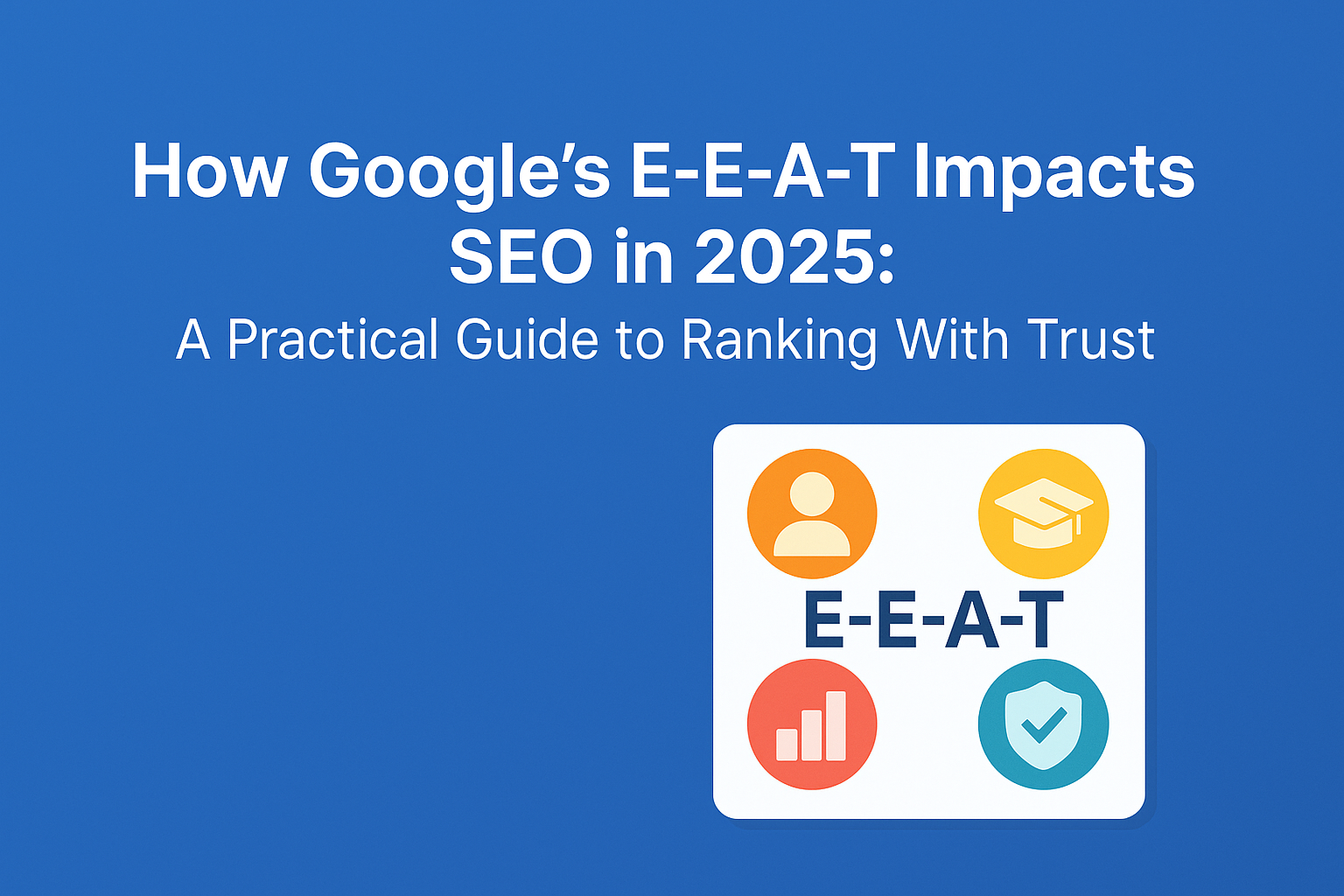How Google’s E-E-A-T Impacts SEO in 2025: A Practical Guide to Ranking With Trust
What Is E-E-A-T and Why It Matters for SEO
E-E-A-T stands for Experience, Expertise, Authoritativeness, and Trustworthiness. It is a framework used by Google to evaluate the quality of web content, especially in topics that can impact a person’s health, finances, or safety. Although E-E-A-T is not a direct ranking factor, it strongly influences how Google’s algorithm perceives content quality.
The Evolution from E-A-T to E-E-A-T
Originally introduced as E-A-T in Google’s Search Quality Evaluator Guidelines, the concept evolved to E-E-A-T in December 2022 with the addition of “Experience.” This addition emphasized the value of first-hand knowledge and real-world involvement in the topic being discussed.
Google’s Quality Raters and E-E-A-T Guidelines
Google uses human quality raters to evaluate pages based on E-E-A-T principles. These ratings do not directly influence rankings but help train the algorithm to prioritize pages that align with user expectations and quality standards.
Breaking Down the Four Pillars of E-E-A-T
Breaking Down the Four Pillars of E-E-A-T
Experience: Why First-Hand Knowledge Matters
Google values content created by individuals with real-life experience. For example, a product review written by someone who has used the product is likely to be rated higher than one written by a third-party content writer with no actual usage.
Expertise: Proving You Know Your Stuff
Expertise refers to the depth of knowledge demonstrated in the content. It is especially important for YMYL (Your Money or Your Life) topics. Credentials, certifications, or a history of published works can help establish expertise.
Authoritativeness: Becoming a Recognized Source
Being an authority means others in your industry recognize you as a trustworthy source. Backlinks from reputable websites, mentions by well-known experts, and positive brand sentiment all contribute to your perceived authority.
Trust: The Core of Google’s Ranking Philosophy
Trust is the most critical element. Factors like accurate information, transparent authorship, secure websites (HTTPS), and positive user experiences help build trust with both users and search engines.
How E-E-A-T Influences Google Rankings
Real Examples from High-E-E-A-T Pages
Websites like Mayo Clinic, Investopedia, and WebMD consistently rank well due to their adherence to E-E-A-T principles. Their content is authored by experts, regularly updated, and well-cited, which boosts their credibility.
Industries Where E-E-A-T Is Crucial (YMYL, Health, Finance)
Google is particularly stringent with websites in YMYL categories. If your site offers medical, legal, or financial advice, demonstrating E-E-A-T is not optional—it’s essential.
How to Improve Your Site’s E-E-A-T for Better SEO
Build Author Bios and Show Credentials
Add detailed author bios that include qualifications, industry experience, and links to professional profiles. This transparency builds trust and proves your expertise.
Use Citable Sources and Trusted Links
Support your claims with data and link to credible sources. This signals to Google that your content is based on verifiable information.
Encourage User Reviews and Real Experiences
Invite customers to leave reviews and testimonials. User-generated content showing authentic experiences adds to your site’s trustworthiness and real-world relevance.
Maintain Site Security and Accuracy
Make sure your site uses HTTPS, displays up-to-date content, and has no factual errors. A secure and accurate site increases both user confidence and search visibility.
Common Mistakes That Hurt E-E-A-T and SEO
Thin Content Without Real Insight
Avoid generic, low-effort content. Google’s algorithms are designed to identify superficial writing that lacks value.
Anonymous or Untrustworthy Authors
Pages with no clear author or unverifiable credentials are less likely to rank well. Always attribute content to qualified individuals.
Lack of Transparency or Contact Info
Websites that don’t offer clear contact methods, About pages, or editorial policies often struggle to earn trust.
Tools and Techniques to Measure and Boost E-E-A-T
- Use SEO tools like Semrush, Ahrefs, or Moz to monitor backlinks and domain authority.
- Regularly audit content for accuracy and update old posts.
- Utilize schema markup to highlight authorship, ratings, and business details.
- Conduct surveys or interviews with subject matter experts to enrich your content.
Final Thoughts: E-E-A-T Isn’t a Ranking Factor—It’s a Success Framework
While E-E-A-T is not an algorithmic signal in itself, it represents a framework that aligns closely with what Google values: content that is useful, credible, and user-centric. In 2025 and beyond, websites that prioritize real expertise, transparent authorship, and trustworthy practices will consistently outrank those that don’t. Implementing E-E-A-T is not just about better rankings—it’s about building a brand that people and search engines can believe in.
